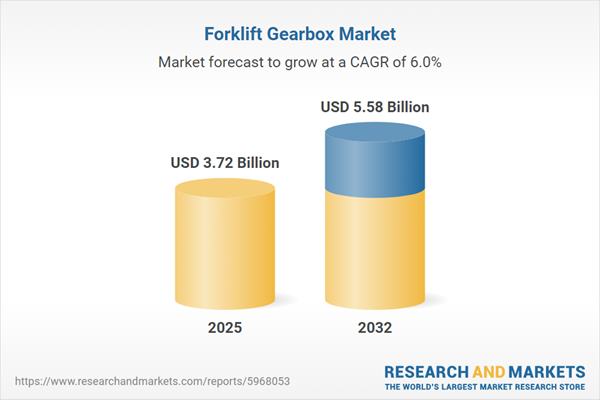Speak directly to the analyst to clarify any post sales queries you may have.
The forklift gearbox market is evolving rapidly as supply chain modernization and digital technology adoption reshape global material handling. Senior decision-makers must stay informed as innovations and regulatory dynamics create new opportunities and risks within this critical industrial segment.
Market Snapshot: Forklift Gearbox Market Growth and Outlook
The Forklift Gearbox Market grew from USD 3.51 billion in 2024 to USD 3.72 billion in 2025. It is expected to continue growing at a CAGR of 5.98%, reaching USD 5.58 billion by 2032. This robust upward trajectory places forklift gearbox solutions at the forefront of efficient power transmission and reliability across supply chain and manufacturing industries worldwide.
Scope & Segmentation of the Forklift Gearbox Industry
This analysis delivers comprehensive insights into the structural complexity and growth factors shaping the global forklift gearbox market:
- Lifting Capacity:
- Up To 3 Ton
- 3-5 Ton
- Above 5 Ton
- Power Source:
- Diesel – Naturally Aspirated, Turbocharged
- Electric – Lead Acid Battery, Lithium Ion Battery
- Gasoline
- LPG
- End-User Industry:
- Construction – Infrastructure, Residential
- Logistics & Transportation
- Manufacturing – Automotive, Food & Beverage, Pharmaceuticals
- Warehousing
- Geography:
- Americas – North America (United States, Canada, Mexico), Latin America (Brazil, Argentina, Chile, Colombia, Peru)
- Europe, Middle East & Africa – Europe (United Kingdom, Germany, France, Russia, Italy, Spain, Netherlands, Sweden, Poland, Switzerland), Middle East (UAE, Saudi Arabia, Qatar, Turkey, Israel), Africa (South Africa, Nigeria, Egypt, Kenya)
- Asia-Pacific – China, India, Japan, Australia, South Korea, Indonesia, Thailand, Malaysia, Singapore, Taiwan
- Leading Companies:
- Toyota Industries Corporation
- KION Group AG
- Jungheinrich AG
- Mitsubishi Logisnext Co., Ltd.
- Hyster-Yale Materials Handling, Inc.
- Anhui Heli Co., Ltd.
- Hangcha Group Co., Ltd.
- Clark Material Handling Company
- Doosan Industrial Vehicle Co., Ltd.
- Unicarriers Corporation
Key Takeaways for Senior Leaders
- Technological advancements are turning gearboxes into intelligent assets capable of delivering predictive diagnostics and optimizing lifecycle management.
- Electrification and material innovation are accelerating, with OEMs investing in lightweight designs and smart sensor integration to meet sustainability and efficiency objectives.
- Regional market demands are highly differentiated, with advanced automation gaining ground in APAC and emission-reduction driving innovation in Europe.
- End-user requirements vary considerably: logistic hubs seek long operating hours and seamless system integration, while construction sites prioritize durability and mobility.
- Strategic alliances, R&D initiatives, and targeted acquisitions remain pivotal for competitive positioning as product portfolios shift to accommodate diesel and electric fleets.
- Segmented solutions tailored by lifting capacity and powertrain type are essential for success across diverse application environments.
Tariff Impact: Effects on Cost Structures and Trade
The 2025 United States tariff measures will directly affect supply chain costs for both domestic and global forklift gearbox stakeholders. OEMs may need to adjust sourcing strategies, from evaluating suppliers in tariff-exempt locations to establishing buffer inventories. Regional manufacturing may gain momentum as businesses seek to minimize risk. These changes in cost structures and trade flows demand close attention from organizations planning future market entry or expansion.
Methodology & Data Sources
This report integrates thorough secondary research (industry publications, patent databases, regulatory filings) with in-depth primary interviews and structured surveys involving OEM leadership, component suppliers, and end-user managers. Data triangulation, thematic analysis, and peer review underpin the accuracy and depth of findings presented.
Why This Report Matters
- Uncover actionable trends and pinpoint high-impact innovations in the forklift gearbox market to guide multi-year capital and R&D decisions.
- Assess risks and opportunities stemming from evolving tariffs, regional differentiation, and shifting end-user priorities.
- Leverage segmentation insights to maximize return on strategic investments in powertrain and component capabilities.
Conclusion
For stakeholders navigating the forklift gearbox market’s transition, this analysis provides the understanding needed to drive growth, mitigate risk, and align technology strategies with emerging demand across global regions and industries.
Additional Product Information:
- Purchase of this report includes 1 year online access with quarterly updates.
- This report can be updated on request. Please contact our Customer Experience team using the Ask a Question widget on our website.
Table of Contents
3. Executive Summary
4. Market Overview
7. Cumulative Impact of Artificial Intelligence 2025
Companies Mentioned
The companies profiled in this Forklift Gearbox market report include:- Toyota Industries Corporation
- KION Group AG
- Jungheinrich AG
- Mitsubishi Logisnext Co., Ltd.
- Hyster-Yale Materials Handling, Inc.
- Anhui Heli Co., Ltd.
- Hangcha Group Co., Ltd.
- Clark Material Handling Company
- Doosan Industrial Vehicle Co., Ltd.
- Unicarriers Corporation
Table Information
| Report Attribute | Details |
|---|---|
| No. of Pages | 196 |
| Published | October 2025 |
| Forecast Period | 2025 - 2032 |
| Estimated Market Value ( USD | $ 3.72 Billion |
| Forecasted Market Value ( USD | $ 5.58 Billion |
| Compound Annual Growth Rate | 5.9% |
| Regions Covered | Global |
| No. of Companies Mentioned | 11 |









